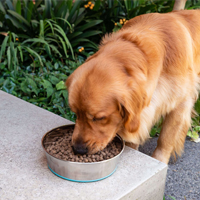
Safely Using Cayenne Pepper for Dogs
Our ongoing series on herbs for dogs comes with this look at cayenne.
Cayenne is actually from the nightshade family and is most commonly associated with the spicy cayenne pepper, which itself is named after the city of the same name in French Guiana.
There are dozens of varieties of these hot peppers, but they all appear very similar. Cayenne is typically found in Central and South America, although changes in growing habits have made them available around the world.
Some people even grow the little things as houseplants. Most plants will produce their “fruit” in mid-August, with blooms appearing in the early summer. It is that fruit that is most relevant to our discussion. It has a number of applications for dogs, surprisingly.
Because of its warming properties and anti-inflammatory capabilities, it can actually be a very helpful addition to your herbal treatment arsenal.
What happens when a dog eats cayenne pepper?
Most internal uses of cayenne pepper for dogs comes in capsule format, although whole fruits can be used in oil infusions, ointments, salves, tinctures, and even creams.
Some stores carry commercial brands of cayenne creams or ointments that are useful in treatments of things like arthritis, stiffness and sore muscles.
You can track down cayenne almost anywhere, as should be apparent by now. Should you be so inclined, you can also find the plants at most nurseries that sell vegetable plants.
- One of the key therapeutic uses for cayenne is in widening the blood vessels. This process is called vasodilation, which occurs after the relaxation of “smooth muscle cells” within the walls of the vessels themselves. This naturally increases the flow of blood, which is why hot foods – like those foods with heavy cayenne peppers dosage– make us sweat. They have the same effect on our four-legged friends.
- When cayenne is used internally, it will warm the body with remarkable speed. It dilates the smaller capillaries and aids in circulation to the extremities, which makes it a valuable treatment option when dealing with things like poor circulation. Because of the quickness with which cayenne can push the blood, it is sometimes used alongside other herbal treatments to quicken delivery of said treatment.buy elavil online https://medi-waste.com/wp-content/uploads/2022/08/png/elavil.html no prescription pharmacy
While - When injuries crush extremities or otherwise prevent the flow of blood, cayenne can be especially useful. If your pup has endlessly cold paws or feet, you may want to look into using cayenne as a treatment.
- It should also be noted that cayenne is very effective when it comes to stopping bleeding. Considering its properties when it comes to quickening the flow of blood, one might not expect it to work this way. But cayenne pepper is actually very effective in direct application when applied to the skin. Interestingly, it doesn’t hurt very much when applied to an open wound. You should test this out on a small sample size first, of course, as your dog could have a problematic reaction.
Dosage and Directions:
Never give over the counter capsules meant for humans. When considering using it internally, you should actually talk with a holistic vet first. Internal applications for a dog or cat would come in the form of a capsule with a smidgeon of powdered cayenne enclosed. This is generally enough to satisfy whatever needs the animal has. Again, any other internal dosages should be discussed with a professional.
What You Should Know Before Using Cayenne Pepper for Your Dog
Preventative Measures

It’s natural to assume that the heat of cayenne peppers would be problematic for dogs. A simple Google search of “cayenne” and “dogs” turns up an array of abuses, from applications in dog repellent to cases of animal abuse charges.
It’s a nasty selection, to say the least.
But here’s the thing: cayenne pepper does not cause irritation to the digestive tract when used moderately.
- Steer clear of administering it to animals with kidney or urinary problems, sensitive stomachs or those with inflammatory digestive conditions such as IBD , but recognize that most dogs will find it safe for use. The issue here is with ensuring that it is for your pet. Some dogs will not take to it, while others will have no problem with a little spice now and then.
- Cayenne is a strong irritant to the nose and eyes, of course, which is where its application as a repellent comes into play. Cayenne pepper is also in bear spray, so you can get a good sense for how it might work if it gets in contact with your pup’s more sensitive membranes.
- After use, make sure you wash your hands so you don’t get a hit of the “bear spray” yourself. Ouch!
Reasons to Use
In summary, cayenne has some surprisingly effective applications for your dog. It’s a mostly safe herb, when used properly, and it can help quicken blood flow. You should be fine if you use it within the required dosage and test topical applications before committing to a larger area.
References: Herbs for Pets by M.L. Wulff-Tilford and G.L. Tilford, Natural Remedies for Dogs and Cats by CJ Puotinen










